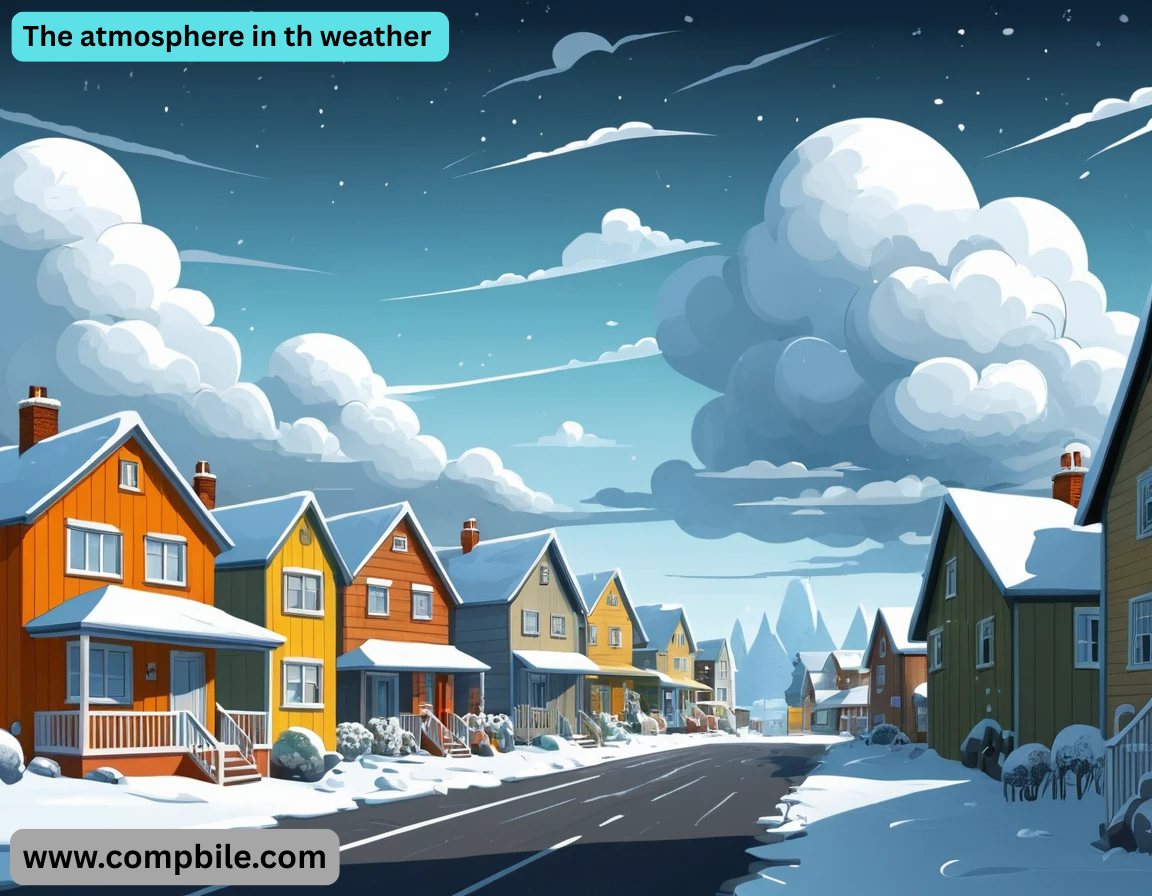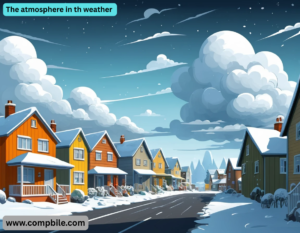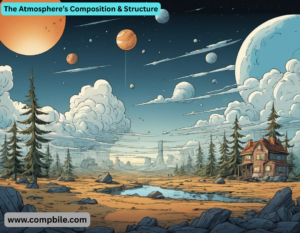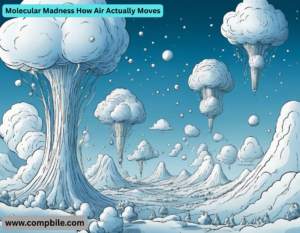The atmosphere in th weather If you’re asking about “the atmosphere in the weather,” here’s an explanation:
- The atmosphere is the layer of gases surrounding Earth, and it plays a crucial role in weather phenomena. Weather occurs primarily in the troposphere, the lowest layer of the atmosphere, where processes like:
- Heat exchange (sunlight warming the Earth)
- Air pressure differences (causing wind)
- Humidity & condensation (leading to clouds & precipitation)
- Storms & fronts (driven by temperature and pressure changes)
- Without the atmosphere, Earth would have no weather as we know it—just extreme temperatures like on the Moon.
Layers of the Atmosphere & Weather
- Weather happens almost entirely in the troposphere (0–12 km altitude), where:
- Temperature decreases with height → causes convection (rising warm air, sinking cold air).
- Water vapor exists → forms clouds, rain, snow.
- Air pressure varies → creates wind.
- Higher layers (like the stratosphere) affect climate but not daily weather.
Key Atmospheric Processes Driving Weather
A. Solar Heating → Temperature Differences
- Sunlight heats Earth unevenly (equator vs. poles).
- Warm air rises → low pressure; cold air sinks → high pressure.
- Result: Wind (air moves from high to low pressure).
B. Humidity & Condensation → Clouds & Storms
- The atmosphere in th weather Evaporation adds water vapor to air.
- Rising air cools → vapor condenses into clouds.
- If uplift is strong → thunderstorms, hurricanes, snowstorms.
C. Air Masses & Fronts → Weather Changes
- Warm front (warm air overrides cold air) → steady rain.
D. Pressure Systems
- High pressure = sinking air → clear skies.
- Low pressure = rising air → storms, rain.
Extreme Weather & the Atmosphere
- Hurricanes: Need warm ocean water + moist air + low wind shear.
- Tornadoes: Form from severe thunderstorms with rotating updrafts.
- Blizzards: Cold air + moisture → heavy snow + strong winds.
Climate vs. Weather
- Weather = Short-term (hours to days).
- Climate = Long-term atmospheric patterns (30+ years).
- The atmosphere’s composition (CO₂, methane) affects climate change.
The Atmosphere’s Composition & Structure
A. Gas Composition (Dry Air by Volume)
- 78% Nitrogen (N₂) – Chemically inert but crucial for pressure.
- 21% Oxygen (O₂) – Supports life and combustion.
- 1% Argon (Ar) – Noble gas, no direct weather role.
- 0.04% Carbon Dioxide (CO₂) – Greenhouse gas, traps heat.
- Variable Water Vapor (H₂O) – Ranges from 0% to 4%, drives storms.
The Physics of Weather Formation
A. Solar Radiation & Heat Transfer
- Shortwave Radiation (Sunlight)
- Passes through atmosphere, heats Earth’s surface.
- Dark surfaces (land, oceans) absorb more; ice reflects (albedo effect).
- Longwave Radiation (Infrared, Heat)
- Earth re-emits heat → absorbed by greenhouse gases (H₂O, CO₂, CH₄).
B. Atmospheric Pressure & Wind
- Ideal Gas Law (PV = nRT) explains pressure changes.
- Coriolis Effect: Earth’s rotation deflects wind (right in N. Hemisphere, left in S. Hemisphere).
- Geostrophic Wind: High-altitude winds balance pressure gradient & Coriolis (jet streams).
C. Moisture & Phase Changes
- Latent Heat: Energy absorbed/released when water changes phase.
- Evaporation cools air (takes heat).
- Condensation warms air (releases heat → fuels storms).
- Relative Humidity (%): Actual H₂O vapor / max possible at that temp.
- Dew Point: Temp where air saturates → fog, clouds.
Storm Formation Mechanisms
A. Thunderstorms (Cumulonimbus Clouds)
- Updraft: Warm, moist air rises rapidly.
- Condensation: Forms ice crystals & water droplets → lightning.
- Downdraft: Rain-cooled air crashes down → gust fronts.
B. Tornadoes (Mesocyclone Spin-Up)
- Supercell Thunderstorm + wind shear → rotating updraft (mesocyclone).
- Vortex Stretching: Updraft tilts rotation vertically → tornado.
C. Hurricanes (Tropical Cyclones)
- Formation Requirements:
- The atmosphere in th weather Sea surface temp > 26.5°C (80°F).
- Low wind shear.
- Coriolis force (no hurricanes at equator).
- Energy Source: Latent heat from ocean evaporation.
Advanced Concepts
A. Atmospheric Waves (Rossby, Gravity Waves)
- Rossby Waves: Large meanders in jet stream → block weather patterns.
- Gravity Waves: Ripples from mountains/thunderstorms → turbulence.
B. Chaos Theory & Weather Prediction
- Butterfly Effect: Tiny changes in initial conditions → vastly different forecasts.
- Numerical Weather Models (NWP): Supercomputers solve fluid dynamics equations.
C. Climate Change Impacts
- Arctic amplification → weaker jet stream → stalled weather (heatwaves, floods).
Experimental Phenomena
- Sprites & Blue Jets: Lightning-like discharges above storms.
- Bomb Cyclones: Rapid pressure drop (>24 mb/24 hrs) → violent storms.
- Derechos: Straight-line windstorms > 58 mph (93 km/h).
Molecular Madness How Air Actually Moves
A. Kinetic Theory of Gases (Maxwell-Boltzmann Distribution)
- Air molecules don’t just “flow”—they bounce chaotically at ~1,000 mph (1,600 km/h) at room temp.
- Mean free path: Average distance a molecule travels before colliding (~68 nm at sea level).
- Why does this matter? Because viscosity (air’s “thickness”) depends on these collisions.
B. The Navier-Stokes Equations (The Unsolved Problem)
- The Holy Grail of fluid dynamics—describes how air moves.
- Problem: No general solution exists (one of the Clay Institute’s Millennium Prize Problems).
- Simplified versions are used in weather models, but turbulence remains a nightmare.
- At very high altitudes (>100 km), air molecules are so sparse they rarely collide.
- This is why satellites experience molecular drag, not wind resistance.
Quantum Weirdness in Weather
A. Water’s Hydrogen Bonds (The Secret of Latent Heat)
- The atmosphere in th weather This is why sweating cools you: your body steals heat to break H-bonds.
B. The Strange Case of Ice Nucleation
- Homogeneous nucleation: Pure water won’t freeze until -38°C (-36°F).
- Heterogeneous nucleation: Dust/bacteria (like Pseudomonas syringae) help ice form at -2°C (28°F).
C. The “Spooky” Greenhouse Effect (Quantum Vibrations)
- CO₂ absorbs infrared (IR) because its molecular bonds vibrate at IR frequencies.
- Methane (CH₄) is 25x stronger than CO₂ (per molecule) because it has more vibrational modes.
Obscure Atmospheric Phenomena
B. The Omega Equation (How Air Rises Without Heat)
- Q-vectors: Show where air must rise due to vorticity stretching.
- Explains why storms form even without surface heating.
C. The Madden-Julian Oscillation (MJO)
- Triggers monsoons, hurricanes, and El Niño-like effects.
The Dark Arts of Weather Prediction
A. Ensemble Forecasting (Monte Carlo Chaos)
- Run 50+ simulations with slightly tweaked starting conditions.
- If 45/50 predict a hurricane → high confidence.
The Future: Wild & Speculative
A. Atmospheric Lasers (LIDAR & Weather Control)
- China uses salt-particle lasers to trigger rain.
- Could we steer hurricanes with stratospheric heating? (Theoretical.)
B. Hyperlocal Weather Manipulation
- Dubai’s cloud-seeding drones boost rainfall by 35%.
- Future: AI-controlled wind farms might disrupt tornadoes.
C. Exometeorology (Weather on Other Planets)
- Venus: Superrotating atmosphere (hurricane winds, but no storms).
- Titan: Methane monsoons & icy “sand dunes.”
The Nuclear Secrets of Thunderstorms
A. Terrestrial Gamma-Ray Flashes (TGFs)
- The atmosphere in th weather Lightning sometimes creates antimatter.
- NASA satellites detect gamma-ray bursts from thunderstorms—caused by electrons accelerating near light speed in electric fields, producing positrons (antielectrons).
- Proof: Fermi Gamma-Ray Space Telescope caught a thunderstorm emitting a 511 keV gamma-ray line—the signature of positron annihilation.
B. Sprites, Elves & Blue Jets (Upper-Atmospheric Lightning)
- Sprites: Red jellyfish-shaped discharges at 80 km altitude, triggered by lightning’s electromagnetic pulse (EMP).
- ELVES: Donut-shaped ultraviolet rings expanding at Mach 300.
C. St. Elmo’s Fire (Plasma Sheath Effect)
- When electric fields ionize air around sharp objects (ship masts, airplane wings), creating a glowing plasma corona.
- Sailors thought it was a ghostly omen—but it’s just electron avalanches.
Get article on pdf file….Click now
……..The atmosphere in th weather……..





